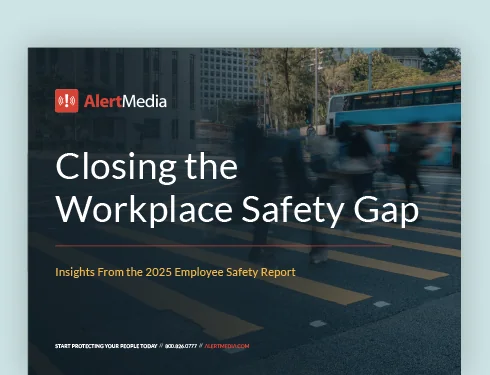
HR’s Role in Safety: How HR Wins With Effective Emergency Communication
As organizations around the world adapt to a new way of working and an evolving business landscape, HR’s role in safety has never been more important.

The COVID-19 crisis has fundamentally transformed the HR function and amplified the impact it can have on the business. As organizations around the world adapt to a new way of working and an evolving business landscape, the role of HR has never been more challenging—or more important.
One of HR’s core responsibilities is to implement human capital strategies that enable the organization to meet its current and future talent needs. But for any HR initiative or program to achieve its full potential—especially given our current circumstances—employee health and safety has to be at the top of HR’s agenda.
Personal safety is a basic employee need. Without this need fulfilled, employees simply can’t perform their jobs effectively. They are distracted, disengaged, and disinterested when they believe they have an unsafe work environment—or that their employer doesn’t care enough to provide them with one. Who wants to go the extra mile for a company that doesn’t care about their safety?
Employee experience is a hot topic in HR circles these days, but nothing impacts the employee experience more than ensuring your people feel physically and psychologically safe at work. While employee health and safety can sometimes feel like the “hot potato” in organizations without a dedicated resource, it’s a key responsibility that HR leaders in every organization should take up. And in fact, there are substantial benefits for HR teams that choose to do so.
“34% of HR professionals worry about emotional & psychological safety, while 20% dealt with this issue in the last year. Almost 1 in 4 of the HR professionals we surveyed were unprepared or unsure about how prepared they were to handle emotional well-being at work.”
Why HR Should Care About Employee Safety
Not only does prioritizing employee safety protect the business from costly litigation and help the organization meet its duty of care, but it can also have an enormous impact on the strategic goals and objectives of the HR function. After all, when employees see their safety and well-being are valued by the organization, employee morale, retention, and productivity all go up.
Here are just a few ways the HR function can benefit from increased employee safety:
1. It strengthens your talent acquisition and employer branding strategies.
Having a reputation as an organization that cares about the safety and well-being of its people can help you attract and engage in-demand talent. In fact, one study found that the safety of the work environment was among the top criteria employees consider when evaluating a new job offer—even ahead of factors such as the quality of potential coworkers and opportunities for professional growth.
Creating a culture of health and safety in the workplace can also strengthen your employer brand, which in turn can reduce turnover by 28 percent, attract 50 percent more qualified applicants, and cut your cost per hire in half according to a recent LinkedIn report.
2. It is a known driver of employee engagement, productivity, and retention.
Just like Maslow’s famous hierarchy of needs theorizes that people must have their basic physiological and safety needs met before they can achieve self-actualization, so too must employees feel safe and secure before they can be motivated and engaged to give their best at work.
Having robust employee safety programs will help you improve employee morale, security, confidence, peace of mind, and ultimately, engagement. And according to Gallup research, highly engaged teams are 17 percent more productive and experience up to 59 percent less turnover.
3. It directly impacts the bottom line, expanding HR’s role as a strategic business partner.
Employers pay almost $1 billion per week for direct workers’ compensation costs alone, and according to the Journal of Occupational and Environmental Medicine, “Companies that build a culture of health by focusing on the well-being and safety of their workforce yield greater value for their investors.” In fact, every dollar invested in safety programs has been shown to provide a payback of $4 to $6 in reduced costs.
By establishing policies, procedures, and practices aimed at ensuring the health, safety, and well-being of employees, HR can protect the bottom line from costs associated with absenteeism, lost productivity, rising insurance premiums, and workers compensation claims—just to name a few. And, in the process, earn—and keep—their seat at the executive table.
So, the individual, organizational, and HR benefits are clear, and you’re convinced it’s time for your HR team to tackle employee safety—but where do you start?
Communicating With Employees During Emergencies
One of the most significant ways to improve employee safety is through better employee communication. And ensuring the rapid flow of accurate information is even more critical during emergency situations. In fact, “Studies show that during an incident, information is as critically important to people as food or water. Not only can accurate information mean the difference between life and death, it can provide reassurance that response and recovery are truly underway.”
When severe winter weather hits, for example, quickly notifying impacted employees of dangerous road conditions can prevent accidents and reduce the chances of injury. In the case of a disease outbreak, timely, relevant communication can help employees minimize exposure and reduce the risk of transmission. And in the case of a major natural disaster or act of violence, effective communication can even mean the difference between a safe escape and a tragedy.
Every organization will experience critical situations, but with an effective emergency communication plan—and the technology that enables it—HR leaders can prevent these incidents from escalating into crises that impact employee safety.
Using Technology to Improve Safety
With emergency communication software, HR teams can easily and dramatically improve the way they communicate with employees during critical events. Whether you’re reaching out to 100 or 10,000 people, a reliable, modern mass notification system can keep everyone connected during critical events and ensure everyone gets the messages they need, when they need them. A system that offers multi-channel, two-way messaging—along with HR system integration, real-time location tracking, and local threat monitoring capabilities—can help HR leaders keep their people safe and informed when it matters most.

![11 Steps to Creating an Effective Emergency Response Plan [+ Template]](https://www.alertmedia.com/wp-content/uploads/2023/10/Blog-Emergency-Response-Plan.webp)


